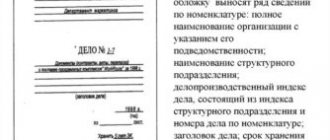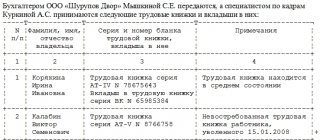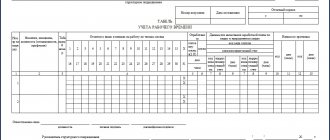Posted in topic: Office management
Orders for personnel are grouped into a separate file, and have their own numbering (different from orders for main activities). Within the file, documents are systematized according to the chronology of their creation.
Some types of orders for personnel are usually issued in a unified form. In this case, you just need to fill in the appropriate fields. The rest are compiled in free form, but at the same time it is necessary to adhere to certain requirements. If an order is drawn up in a non-unified form, the same recommendations are applied as for drawing up an order for the main activity.
What it is?
The first step is to figure out what we're talking about. What are personnel orders? After all, before you start storing something, you need to fully understand what kind of documentation you will have to work with.
Personnel orders are papers regulating labor relations between an employee and an employer. This documentation is anything that can point to files and information that relates to the activity. All orders are divided into several categories:
- Long-term storage documents.
- Short-term papers.
- Temporary orders.
Accordingly, each category has its own characteristics. Therefore, before you begin to study the theory of storing and accounting for personnel documentation in a company, you need to understand what type of paper this or that one belongs to. Only after this will it be possible, without violating the established rules, to carry out the processes being studied. What are the storage periods for personnel orders? What should every employer know about this moment?
What is a personal matter
An employee’s personal file is a package of documents and information about the employee regarding the positions he holds and work at the enterprise. This set of documents is prepared for each employee of the organization.
According to Federal Law No. 79-FZ and Decree of the President of the Russian Federation No. 609, maintaining personal files is mandatory for civil servants, for other categories - at the request of the employer.
In practice, every enterprise keeps records of personal files, which helps to systematize the work of the personnel department and the organization.
Long-term documents
Now is the time to look at each type of document previously listed. It has already been said that this will help to fully understand exactly how long to store documentation. But the accounting for all types of securities is the same. Therefore, the question usually does not cause difficulties. The storage period for personnel documents directly depends on the type of paper. The first is long-term storage orders. It is not difficult to guess that they will be taken into account by the employer and will remain for a long time. How much exactly? More on this a little later.
What can be attributed to this documentation? These are documents that describe the labor relationship between the employer and subordinates, and also indicate significant work factors. What can be attributed to them? This:
- An employment contract with an order for employment.
- Translation documents.
- Orders establishing a certain salary for a particular position.
- Certificates confirming awards or bonuses to employees.
- Papers about business trips (long-term, foreign).
- Personnel personnel files.
- Questionnaires to be filled out during employment.
- Orders of dismissal.
Who has access to personal files
All cases contain personal data (PD), and compliance with the requirements for their protection is the direct responsibility of employers (Chapter 14 of the Labor Code of the Russian Federation, Federal Law No. 152). The list of persons with access to personal data is approved by order of the head. At the same time, persons who have access to PD are obliged not to disclose to third parties or distribute this data without the consent of the PD subject, unless otherwise provided by federal law.
The head of the organization, by order, appoints those responsible for maintaining and storing personal records (usually the head of the personnel department and his subordinates), and also approves the list of persons who have access to them (this information can also be fixed in the Instructions for maintaining personal files). This list usually includes:
- the head of the organization and his staff deputies;
- head and employees of the HR department;
- head and employees of the legal service;
- accounting employees who calculate wages and make tax and other deductions;
- heads of structural units (in relation to subordinate employees);
- other responsible employees approved by order.
Representatives of third-party organizations can access LD only with the permission of the head of the organization upon an official written request.
Not by personnel
Now it is clear which documents are considered long-term. The only thing is that the order to hire an employee is a document that relates to personnel. But there is a small exception to the rule. It should be remembered.
What are we talking about? Not all employment orders together with an employment contract are personnel orders. Similar papers have an exception. There are so-called orders for core activities. Some of the above include:
- An employment contract with the corresponding order.
- Changes to the employment agreement (transfer to another position, for example).
- Documents regarding the dismissal of personnel.
It should be noted that for the main activity, these securities will be considered only in relation to individuals. Usually these are company managers, as well as accountants, supervisors, and deputies. These personnel are often prescribed in the company's charter. This rule should be remembered if the employer wants to know what the storage periods for orders for personnel are. Not all documents fall into this category.
Transferring personal files to the archive
Selected questions encountered when preparing to transfer personal files to the archive
Legal regulation
In this article we will talk about how to overcome mistakes that arise when creating personal files for employees. Just in case, let's say a few words about what constitutes a personal matter.
Personal file - a selection of documents about an employee
The personal file begins with the documents that are drawn up upon admission to work (personal personnel record sheet, autobiography, application for employment, a copy of the hiring order), continues and ends with copies of orders for transfers, part-time work, awards, dismissal of an employee, etc. .
Personal affairs are mentioned in Art. 337 of the Standard List of Management Documents generated in the activities of organizations, indicating storage periods, approved by the Federal Archive on October 6, 2000 (hereinafter referred to as the Standard List).
At the same time, it should be noted that personal affairs are mainly conducted in the records management of those personnel services that are government bodies and whose employees, in accordance with current legislation, are classified as civil servants. In other organizations, personal affairs are conducted at the discretion of personnel services.
Due to the fact that current legislation requires maintaining only personal files of civil servants, many commercial organizations currently simply refuse to maintain personal files, leaving only personal cards for personnel records management.
Standard list of documents
According to the Standard List, personal files of the organization’s leaders, members of the organization’s governing, executive, and control bodies; employees with state and other titles, prizes, awards, academic degrees and titles are kept permanently, for other employees - 75 years. Based on paragraphs. 3.6.3 of the Basic Rules for the Operation of Archives of Organizations, personal files of employees need to be fully documented.
Full registration of cases includes:
- file filing or binding;
- numbering of case sheets;
- drawing up a certification sheet;
- drawing up, if necessary, an internal inventory of documents;
- introducing the necessary clarifications into the details of the cover of the case (clarification of the name of the organization, the registration index of the case, the deadlines of the case, the title of the case).
The rules also describe other requirements for the formation of personal files.
In addition, by Decree of the President of the Russian Federation dated 06/01/1998 N 640, from the total volume of personal files compiled by personnel services of organizations, personal files of persons holding public positions of the Russian Federation in the order of appointment and public positions of the federal civil service are allocated into a separate group (the Decree does not apply regarding the procedure for maintaining personal affairs of state civil servants of the Russian Federation).
In addition, there are regulations of the relevant departments that should guide subordinate organizations, for example, Requirements for organizing office work in non-state pension funds, approved by Order of the Inspectorate of Non-State Pension Funds under the Ministry of Labor of Russia dated August 31, 2001 N 115.
Problems and solutions
However, when creating personal files, problems often arise, specific solutions to which are not provided for by current legislation. Working with personnel archives, the author of this article has encountered such complex issues more than once. In this article I tried to give possible answers to the two most interesting of them.
https://www.youtube.com/watch?v=KxWkRFiRTv0
Question 1: When preparing personal files for archival storage, they often contain documents that do not have dates. This mainly occurs due to the fault of the personnel service employees themselves, who forget to indicate the dates of documents or accept documents without dates from employees. How to generate documents that do not have dates?
Answer: Before answering this question, it is necessary to check whether the documents we are considering are indicated in the inventory of documents in the personal file.
Let us recall that in the internal inventory of documents of a personal file, data on the documents that make it up is entered in the form of a table indicating in its columns the serial number of the document, the name of the document, the date of the document and other necessary information.
Such an inventory is usually compiled by employees of the personnel department, which maintains a specific personal file.
Undated documents should be generated after it
But only on the condition that these documents really should be stored in this personal file, which is established by the relevant regulatory documents - Model or departmental lists, Decree No. 640, etc.
If you can establish that documents included in the second group should not be stored in a personal file, it is necessary to seize such documents and carry out further work with them in accordance with established requirements (form them into separate files or with other files, transfer them according to the delivery list to the archive, or set aside for destruction according to the act, etc.).
Question 2: In the employee’s personal file, the employment order is dated earlier than his application. In what order should the specified documents be formed in the personal file?
Answer: Personal records are usually arranged in chronological order.
However, according to the logic of the events reflected in these documents, the employee first had to write an application for employment, and only then an order should have been issued.
In this case, to systematize documents, a logical sequence should be observed. Based on the meaning of the Basic Rules, the peculiarities of the formation of cases in such non-standard situations should be reflected in the appropriate preface.
The preface could read like this:
Example 1. Individual documents of personal files that do not have dates, but were previously included in the inventory of documents available in the personal file, are formed at the end of each file before the inventory, not recorded - after the inventory. In a number of personal files, employee bypass sheets that were previously included in the inventory of documents available in the personal file were left.
Example 2. In the employee’s personal file, the employment order is dated earlier than the application. This order was not preserved in the process of systematizing the documents of this personal file.
The documents are presented in a logical sequence, that is, in the order that must be followed when applying for a job.
From the situations considered, it is clear how difficult the process of preparing personal files for archival storage is due to their non-compliance with current regulatory documents.
Source: https://mosarchiv.ru/stat/peredacha-v-arkhiv-lichnykh-del-/
Short term storage
Next, you need to figure out what can be classified as short-term storage papers. Of course, some kind of accounting of orders for personnel in this situation will be made. But after a short period of time, such documents will be destroyed. What can be classified into this category? Short-term storage documents are orders that promptly regulate an employee’s performance of a particular work activity. That is, these are not such serious documents as resignation papers or an employment contract. More specifically, we can highlight:
- Leave orders.
- Directions for short business trips.
- Documents indicating various disciplinary actions.
- Orders on sending personnel to training or advanced training courses.
But that is not all. The rules for storing studied documents have many features and nuances. In addition to the options already discussed, we can distinguish between temporary and permanent storage. These cases do not occur too often.
What documents from the employee’s personal file are archived?
Labor Code of the Russian Federation (Article 65) on a specific list of documents provided by employees when concluding an employment contract. The procedure for the formation of personal files and the requirements for the preparation of personal files transferred to the archive are approved by the “Basic Rules for the Operation of Organizational Archives”, approved by the decision of the Board of Rosarkhiv dated 06.02.2002. According to clause 3. 5 of these Rules, the procedure for creating a personal file is as follows: Documents that, in their content, correspond to the title of the case are placed in the file, while it is prohibited to group draft and doublet copies of documents (with the exception of especially valuable ones) into files, as well as documents , subject to return. The personal file should contain no more than 250 sheets, with a thickness of no more than 4 cm. Inside the file, documents should be arranged so that their content consistently covers certain issues.
Ministry of Culture of Russia dated August 25, 2010 No. 558). Read more about dismissal here: Thus, orders for hiring, transfer, dismissal and other orders for personnel must be kept for at least 75 years. An exception to this rule is orders for granting vacations, sending on business trips in Russia (as well as other documents about business trips: assignments, reports, etc.), as well as orders for penalties.
They only need to be stored for five years. Employment contracts, personal cards and personal files of employees must also be kept for 75 years, and personal files of managers - permanently. The staffing table is also required to be maintained at all times. Workplace certification materials should be stored for 45 years, and in difficult, harmful or dangerous working conditions - 75 years.
Keep the labor regulations even after replacing them with new ones. Shelf life is one year. Place notes on the verification of your personal file in the addition to your personal personnel record sheet. Nina KovyazinaDeputy Director of the Department of Education and Human Resources of the Ministry of Health of Russia 2. How to store documents in the personnel service Documents required for storage Legislation obliges all employers to ensure the storage of archival documents that are generated in the course of their activities (clause 1 of Article 17 of the Law of October 22, 2004 No. 125-FZ). The personnel department of an organization is, as a rule, responsible for storing documents on personnel. Storage periods for documents The periods during which documents on personnel must be stored are indicated in the list approved by order of the Ministry of Culture of Russia dated August 25, 2010 No. 558.
The beginning of the storage period for documents is considered to be January 1 of the year following the year in which they were compiled (paragraph 4, paragraph. The fact is that paragraph 3 of Article 264 of the Tax Code of the Russian Federation establishes that in order to write off these costs to reduce taxable profit, the organization must store all documents confirming training (agreement with an educational institution, an order from a manager to send an employee for training, an act of provision of services, a diploma, a certificate, etc.) Their storage period is limited to the validity period of the training contract and one year of the employee’s work, but at least four years Question Good afternoon, tell me how to file the personal files of dismissed employees (we don’t have an archive as such, just a separate office).
Currently, I have made an internal inventory of all the documents that are in the personal files of those dismissed, placed this inventory as the first sheet in the LD, then they go in order - dismissal order, resignation letter, additional. termination agreement, acceptance order, etc., including all copies of documents under Art. 65 TC All sheets were numbered (for example, there are 40 of them), and on the first sheet of the LD, where the employee’s name is written, the date started, date ended, on 40 sheets, kept for 75 years. The last details are included in the archive. Rice.
6. 5. During the period of preparation of cases by a structural unit for transfer to the archive of the organization, the archive employee first checks the correctness of their formation, execution and compliance of the number of cases included in the inventory of cases (of the structural unit) with the number of cases opened in accordance with the nomenclature of the organization’s files. Employees of the structural unit are required to eliminate all deficiencies in the formation and execution of cases identified during the inspection. If a lack of cases is detected, a corresponding certificate is drawn up.
Each case is accepted by the person responsible for the organization’s archive in the presence of an employee of the structural unit.
You independently compile a list of documents to be included in it: For example, such documents include: documents on the employee’s education, information on assignment to work; characteristics, letters of recommendation (if available); documents reflecting issues of admission, internal transfer (transfer) and dismissal of an employee (his personal statement, copies or copies of orders and other documents). Requirements for registration of personal files accepted into the archive: In this case, complete registration of files includes: filing or binding of the file; numbering of sheets; drawing up a certification sheet, as well as drawing up (if necessary) an internal inventory of documents; making the necessary clarifications in the details of the cover of the case (clarification of the name of the organization; registration index of the case; deadlines of the case; title of the case) Cases of temporary (up to 10 years inclusive) storage are subject to partial registration. To take into account the number of sheets in the case and record the peculiarities of their numbering, a document certifying sheet is drawn up (see Appendix 2). The document certifying the case is signed by its compiler, indicating the transcript of the signature, position and date of compilation. All subsequent changes in the composition and state of the case (damage, replacement of original documents with copies, addition of new documents, etc.) are noted in the document certifying the case with reference to the relevant act. To record documents of certain categories of cases with permanent and long-term (over 10 years) storage periods, an internal inventory of case documents is compiled. The internal inventory is compiled on a separate sheet according to the established form (see Appendix 3).
A final record is drawn up for the internal inventory of the case, which indicates in numbers and in words the number of documents included in it and the number of sheets of the internal inventory. On the cover of permanent storage files, space is provided for the name of the state archive into which the organization’s files will be accepted, designation of the codes of the state archive and organization. When the name of an organization (structural unit) changes during the period covered by the case documents, or when the case is transferred to another organization (to another structural unit), the new name of this organization or the legal successor organization is indicated on the cover of the case, and the previous name of the organization (structural unit) is enclosed in parentheses. Personnel files are transferred to the archive.
Their transfer is carried out only according to inventories. Cases of temporary (up to 10 years inclusive) storage, as a rule, are not subject to transfer to the archive; they are stored in the personnel service and, upon expiration of the storage period, are subject to destruction in the prescribed manner. They can be transferred to the archive only in exceptional cases by decision of the head of the organization.
Their transfer can be carried out according to the nomenclature of cases. Each case is received by the head (special employee) of the archive (person responsible for the archive) in the presence of a personnel service employee. In this case, on both copies of the inventory, a note about the existence of the case is made against each case included in it. As a result of the examination of value, all files in the personnel service are divided into three groups: permanent storage, long-term storage (over 10 years), temporary storage (up to 10 years inclusive). Methodological and practical assistance to the personnel service in carrying out work on the examination of the value of cases is provided by the records management service, the archive and the expert commission (EC) of the organization, which directs the general process of examination of the value of cases in structural divisions. Case numbers according to nomenclature are indicated on the spines of case covers.
It is prohibited to store documents on unsuitable desktops. The issuance of cases to third-party organizations is carried out with the permission of the head of the organization. A substitute case card or receipt is created for the issued case. Removal of documents from files with permanent storage periods is allowed in exceptional cases and is carried out with the permission of the head of the organization with the obligatory leaving in the file of a certified copy of the document and the act of seizure of the original.
Temporary and permanent
Temporary documents are any orders and instructions that do not play a significant role in work activities. They are usually important at a certain point. And after they are no longer needed, they are destroyed. There are also permanent storage orders. Most often, from the personnel records, only the personal files of managers and other officials specified in the corporation’s charter can be distinguished. Recording and storage of such documentation is carried out on an ongoing basis. And it is destroyed only after the company closes.
Procedure for conducting personal affairs
A personal file (PD) is a set of documents relating to one employee and containing information about his labor (official) activities and length of service.
In budgetary organizations, as a rule, records are maintained for all employees. However, it is possible to conduct them selectively, for example, only for management personnel, financially responsible persons, etc. By maintaining we mean:
- timely entry of records of all changes: personal and biographical information, job position, etc.;
- inclusion of incoming materials and their withdrawal;
- issuance of case materials, certification of copies;
- maintaining an internal inventory;
- periodic checking of the state of affairs;
- closing and preparation for transfer to the archive, etc.
The procedure for maintaining and the list of documents attached to the LD is approved by local regulations.
Long terms
What are the storage periods for personnel orders? It has already been said that a lot depends on what specific papers we are talking about. There is documentation of long-term storage. It must be systematized and taken into account according to established rules. And such documents are stored for a long time.
Given that only some companies are able to operate for a long time after opening, it can be said that long-term papers should not be destroyed on an ongoing basis. Why? The fact is that personnel orders of this category are stored for 75 years. And only after this period has expired can destruction begin. Only some corporations manage to work longer than the specified period.
What documents from the employee’s personal file are archived?
In addition to inventories of files with a permanent storage period, files with a temporary (over 10 years) storage period, personnel services of organizations must annually draw up inventories of files for personnel. Documents on personnel have a special social significance - they are the basis for confirming work experience, position held, duration of work in a given organization and other facts of labor relations. In order to prevent the loss of these documents, most of the documents on the personnel of dismissed workers are archived and stored for 75 years. In connection with the development of computer technology and the increase in the volume of documents on electronic media, organizations have a need to store audiovisual and electronic documentation. In the archive of the organization, depending on the composition and volume of electronic documents, inventories of electronic documents with a permanent storage period are compiled.
An inventory of the affairs of the personnel service is submitted to the archive one year after the completion of the affairs in office work. Responsibility for the timely and high-quality compilation of an inventory of the affairs of the personnel service lies with its head. Before entering the headings of cases into the inventory, the quality of the formation and registration of cases, the correspondence of the number of cases included in the inventory with the number of opened cases according to the nomenclature of cases of the personnel service are checked. When reviewing cases, the following is checked: compliance of the case title with the contents of the documents in the case; correctness of execution and grouping of documents included in the case; the quality of the filing or binding of the case; correct numbering of case sheets; the presence in the case, where necessary, of an internal inventory of the case and its correctness; the correctness of the cover of the case; presence and correctness of the certification sheet of the case. Personnel cases, as a rule, are systematized chronologically. In the archives of large organizations with a large number of employees, the structural and chronological principle of systematizing personal files can be used.
Within each year, personnel matters are systematized according to the degree of importance - orders for enlistment (in an educational institution, etc.), transfers, dismissal (graduation from an educational institution, etc.), personal accounts, lists, accounting logs personnel documents, other registration and accounting documents, personal files, personal cards. In order to ensure safety and consolidate the order of arrangement of documents included in the file, all its sheets, except for the sheets of certification and internal inventory, are numbered in expanded form in Arabic numerals with gross numbering in the upper right corner, without touching the text of the documents, with a black graphic pencil or numberer. The use of ink and colored pencils for numbering sheets is prohibited. When renumbering sheets, the old numbers are crossed out and the new sheet number is placed next to it; at the end of the case, a new certification sheet is drawn up, while the old certification sheet is crossed out, but remains in the file.
If there are individual errors in the numbering of sheets in files when preparing them by the organization’s archive for transfer to state storage, it is allowed, in agreement with the state archive, to use lettered sheet numbers. Each case in the inventory has an independent serial number. If the case consists of several volumes, each volume has its own number. The archive of the organization arranges the files in the inventory in order. He also assigns inventory numbers to the structural unit.
When transferring cases over several years to the archive, they need to be systematized. The usual order of systematization of affairs in an organization is chronological and structural.
About accounting and storage
How long are certain orders for personnel stored? It is not difficult to answer this question. Now you can pay attention to the rules for recording these documents. This is also an important point that every employer should know. After all, if there are any papers that are stored for a certain period of time, it is necessary to somehow keep records of them, otherwise you can lose important orders.
There are now several types of document storage available. They must be implemented in any company. Now companies must create special lists of records of their personnel records, both in paper and electronic form. By the way, the second one can be neglected. But the generally accepted paper form of submission is a mandatory item. But how to do accounting correctly? The principles for the electronic and material versions are the same. More about them later.
How an employee’s personal file is formed
The personal file of a dismissed employee is formed according to the dossier principle and is stored in the personnel department of the organization until the end of the calendar year. Within 3 years after dismissal, documents undergo archival and technical processing and are transferred to the archive.
After archiving, there are some aspects that need to be completed:
- The case needs to be stitched or bound.
- Remove all paper clips and staples, stitch 4 protocols into a hard cover.
- Personal documents are placed in an envelope filed in the file and numbered as a sheet. Each investment is numbered in turn (military ID, work record book, diploma, identity card, etc.).
- At the end of the case, it is necessary to file a blank sheet and draw up a document certifying the case, which is not included in the total number of sheets of the folder.
Documents inside the folder should be arranged chronologically - from the first documents to the last. Thus, the earliest document comes first, for example, consent to data processing, and the last is the order to dismiss the employee.
This is also important to know:
Dismissal at will: article of the Labor Code
According to Decree of the President of the Russian Federation dated May 30, 2005 No. 609, the enterprise implements a mandatory procedure for collecting data on employees. These include the following documents:
- Application form, resume, characteristics and personnel records sheet.
- Copies of passport, educational documents (diplomas, certificates), TIN, insurance certificate, documents on marital status.
- Information from certification.
- Labor contract.
- Employer orders (on appointment, transfer to another position or place of work, vacations and business trips).
Personal file of a dismissed employee, sample internal inventory
Sample of a personal file certification sheet
Basic Accounting Principles
So, recording orders for personnel is a responsible matter and is regulated by generally accepted norms. All personnel documents must be registered. If you do not do this, you may not store this or that paper. No registration - no document. What is meant by this process?
Registration of orders for personnel is the transfer of details written on documents into specialized documentation forms, followed by assigning a number and stamping the date of approval of the paper as recorded. That is, both with paper interpretation and electronic interpretation, it is necessary to assign a digital designation to each order. And also write it down in one form or another. This is a required item.
Data is recorded in personnel order logs. Recording also takes place in electronic databases and archives. This is the only way to fully realize the recording and storage of documents. Companies provide for a free choice of the form of storing documentation. The charter must stipulate rules according to which all orders (or any specific ones) are stored both in paper form and electronically. It is worth noting that the first point is usually mandatory. It is a material document that can confirm this or that order.
Current storage of employee personal files in the HR department
Before an employee is terminated, their personnel file is “in progress.” All documents related to his work activities are filed in the folder, including:
- medical reports and certificates confirming the fact of passing mandatory examinations;
- additional agreements;
- statements and explanatory notes;
- memos and memos from the immediate supervisor;
- copies of orders on awards, transfers and transfers;
- materials of assessment and certification activities;
- acts of acceptance and transfer of personal files of employees transferred to another job, etc.
The manager is obliged not only to organize the storage of personal files of employees in the personnel department, but also to ensure the safety of documents.
What the law says about prompt storage of personal files
Prompt storage of personal files is carried out in accordance with the requirements established by:
- Federal Law No. 125-FZ “On archiving in the Russian Federation.”
- Basic rules for the work of archives of organizations, approved by the decision of the Federal Archives of Russia.
How to store documents in the HR department?
N. KovyazinaDeputy Director of the Department of Medical Education and Personnel Policy in Healthcare of the Russian Ministry of Health. For violation of the rules of storage, acquisition, accounting or use of archival documents, administrative liability is provided (Article of the Code of Administrative Offenses of the Russian Federation). Penalties - a warning or an administrative fine in the amount of: from 100 to... Read the expert’s answer in the “Personnel System” >>
Order log
The most common practice for recording and storing documentation is a company-issued personnel order journal. This document is a small notebook. It records the order numbers, as well as their basic data (details). For example, title and date of approval. The order journal records papers of permanent, long-term and short-term storage. But if we are talking about temporary documentation, then it should not be entered in such a notebook. Unless the company's charter provides for a separate journal intended exclusively for temporary orders. It fills up to the very end. As soon as the free sheets run out, it is necessary to put a new accounting document into operation. The old one is filed and sent for storage. By the way, this is permanent accounting paper.
The legislative framework
- Federal Law dated April 27, 2004 No. 79-FZ
- Decree of the President of the Russian Federation of May 30, 2005 No. 609
- subp. “c” clause 6, part 1, art. 81 Labor Code of the Russian Federation
- Art. 192 Labor Code of the Russian Federation;
- clause 7, part 1, art. 243 Labor Code of the Russian Federation;
- Art. 13.11 Code of Administrative Offenses of the Russian Federation;
- 14 Code of Administrative Offenses of the Russian Federation;
- Art. 137 of the Criminal Code of the Russian Federation;
- 140 of the Criminal Code of the Russian Federation;
- Order of the Ministry of Culture dated August 25, 2010 No. 558;
- “List of standard management archival documents generated in the process of activities of government agencies, local governments and organizations, indicating storage periods” (Order of the Ministry of Culture dated August 25, 2010 No. 558).
Archives
Regardless of what kind of personnel orders we are talking about, each company provides for archival storage of documents. This is the most common form of paper accounting. And everyone. Not necessarily in terms of personnel. All data is sent to archives after they are no longer needed. Or those that have already been completed. For example, personal files of employees. Once the dismissal order is signed and the case is closed, it must be sent to the archives for storage for a specified period. There are several types of data sorting, but more on them later.
To begin with, it should be noted that archives can be presented in paper form (required), as well as electronic. Regardless of this, the company chooses the principles for systematizing stored information. Archival data has an inventory. It provides a short list of all stored documentation. Archival storage of documents is the most convenient form of data recording. It is used in both paper and electronic form. It should be noted that temporary documents are not entered into the archive. They are attached to the main papers and then destroyed. It is recommended that all temporary storage orders be sent to a separate place and not combined with long-term or short-term ones.
Retention period for personal files of dismissed employees
The question often arises, how long are employee personal files kept? LD are long-term storage documents (cases opened after 2003 are stored for 50 years; earlier - 75 years (Article 22.1 of the Federal Law No. 125)), therefore, in the event of an employee’s dismissal, they are subject to careful verification and closure. To do this, all documents in the case are verified, the inventory is closed, a certification sheet is inserted at the end of the case, and then the case is stitched with 4 punctures.
How long is an employee’s personal file kept after dismissal? Archiving of personal files of dismissed employees occurs three years after its closure (for municipal and civil servants this period is 10 years). The records of dismissed employees must be kept separately from the records of existing employees. If the organization has a room for storing archival files, then they are temporarily moved there. If there is no specially equipped room, then they are located either on a separate shelf in the storage room or in another safe.
Tips for organizing
The retention periods for personnel documents are clear. Usually these are 5 and 75 years. But that is not all. Archives require special attention. After registering the order, as well as placing it in the archive, it is necessary to somehow systematize all available data. To this end, companies use several principles:
- Storing documentation in separate folders, dividing into short-term documents and long-term ones. It is recommended not to stack all the papers together.
- Systematization by years, months and dates. Each folder with documents contains orders for a certain time period. Inside, all papers are laid out taking into account their registration in the accounting journal (by month and day). Thus, the task of searching for a particular document is simplified.
- Use of arrangement by order numbers, taking into account alphabetical order. Already inside each folder, it is recommended to systematize by order numbers, as well as by capital letter.
Storing personal files of employees in the HR department
The HR department should keep records of only working employees. They are placed in a specially designated place, excluding access to them by third parties, as well as the possibility of their theft or loss. These must be specially equipped locked safes (metal cabinets) or rooms.
At the storage location, files are arranged in a vertical position by serial numbers, in alphabetical order, by structural divisions, etc. A list of LDs located in it is placed in the storage facility.
All cases are subject to accounting and are recorded in a separate journal. The form of the journal has not been approved, so it can be developed independently, in terms of functionality for a specific organization.
Every day at the end of the working day, HR employees check the availability of cases in the storage room. Then the cabinets (safes) or rooms are closed and sealed. If the absence of LD is detected by the responsible employee, measures are taken to return it or search for it.
End of accounting
What to do after the storage period for a document in the archives expires? A special service in the company checks the papers. Then he systematizes them and allocates specific orders for destruction. Typically, documents are either burned or put through a shredder. In any case, you can’t just throw out orders. It is necessary to destroy them. To assign documents to one type or another, a special commission is involved. It evaluates the importance of orders and assigns them a shelf life. And only then are they placed in archives in one form or another.
Rules for using information
Legal entities, ordinary citizens and government officials are required to ensure the integrity of information about previously employed employees for a certain period.
Representatives of companies and citizens have the right to request information to gain access to the archive of personal files of laid-off workers. Personnel department employees issue certificates and copies of documents free of charge for presentation to the pension fund and social security authorities for receiving benefits.
The available data is also used as evidence. Then the previously seized documents are given to the owner.










